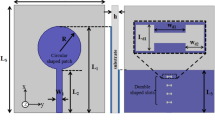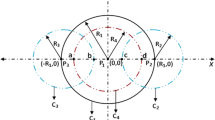Abstract
In this report, we present a compact printed antenna with a defected ground surface for ultra-wideband (UWB). It consists of an asymmetrical hexagonal slot loaded defected ground plan. CPW-fed annular shape radiating patch with two rectangular shape parasitic patches in order to enhance the gain and impedance bandwidth. The proposed antenna is operating between 6.2 and 19.8 GHz, which covers the frequencies of partial C-band, X-band, and Ku-band. The simulation, parametric analysis, and optimization are executed by using HFSS software. The maximum radiation efficiency and peak gain of the proposed antenna are observed 93.3% and 9.34 dB, respectively.
Access provided by Autonomous University of Puebla. Download conference paper PDF
Similar content being viewed by others
Keywords
1 Introduction
With the staggering evolution of printed circuit-based microwave communication systems and standards, the requirement of antennas of miniaturized size, large bandwidth with optimum radiation characteristics, and with ease of fabrication is increasing. Since the last few years, several research papers have been published in the domain of ultra-wideband (UWB) technology [1,2,3,4,5,6,7], which has triggered an upturn in the progress of printed antennas.
However, patch antennas have limitations of their applicability because of their narrowband and poor gain. These limitations can be overcome by the modification of the geometry of conducting patch by cutting the notches and slots of regular and irregular shape on radiating patches [8,9,10], by using the gap coupled parasitic patches [11, 12], replacing solid ground structure by defected ground structure and by stacking of substrates of different dielectric constants [13, 14].
In the proposed article, a miniaturized coplanar waveguide fed annular ring shape printed antenna with a defected ground surface (DGS) is discussed for UWB applications. The operating frequency range of the designed antenna varies from 6.2 to 19.8 GHz which makes the antenna suitable for partial C to Ku-band applications. This antenna comprises a coplanar waveguide (CPW) fed annular shape conducting patch, two parasitic patches of rectangular shape, and an asymmetrical hexagonal slot loaded defected ground plane. This work aims to propose a simple, planar, and compact patch antenna for ultra-wideband operations. To ensure compactness and simplicity a CPW-feed technique with coplanar electromagnetically coupled parasitic patches is used. In Table 1, the comparative analysis is carried out between the designed antenna and reported antennas for ultra-wideband applications with regards to the area of the antenna, operating bandwidth, radiation efficiency, and peak gain.
From the perusal of Table 1, it is found that the area of the designed antenna is compact by the index of 1.06, 2.65, 2, 2.45, and 4 from the antennas reported in Refs. [15, 16, 18, 20, 21], respectively, and has an equal area to the antennas mentioned in Refs. [17, 19]. However, other antenna parameters of the proposed prototype are optimum in comparison with the antennas mentioned in Table 1.
2 Designing of Antenna
A simplified layout of the designed antenna is presented in Fig.1a–c. Low cost, durable, and commercially available FR4 epoxy substrate (εr of 4.4 and tanδ of 0.02) has been used for the designing of the proposed antenna.
The area of the designed antenna is 30 × 30 mm2, and it has a simple configuration that consists of an annular shape radiating patch with outer radius and inner radius of R1 and R2, respectively. It also consists of two rectangular shape parasitic patches with the height of A1 and width of A2. A coplanar waveguide of height A3 and width A4 is used to feed the antenna. The purpose of using coplanar waveguide feed is to achieve impedance matching and other important feathers. A hexagonal asymmetrical slot loaded defected ground is used in the antenna. Detail dimensions are presented in Table 2.
A stepwise analysis is carried out to obtain the optimum structure. Five subsequent steps have been shown in Fig. 2a, and its corresponding simulated |S11| (dB) plot is presented in Fig. 2b. It is clear from the figure that the antennas 1, 2, 3, and 4 behave like ultra-wideband antenna with some band-notch characteristics while antenna 5 covers the entire UWB region of 6.2–19.8 GHz with better return loss (S11< − 10 dB) and with revamped impedance matching. Therefore, antenna 5 is considered as a proposed antenna. It is also worth mentioning that the incorporation of the asymmetrical hexagonal slot on the ground plane increases the operating BW.
Parametric analysis is laid down to find out the effect of variation in dimensions of various parameters like the inner radius of the ring (R2), the position of asymmetrical hexagonal slot on the ground plan (A5), and height of rectangular patches (A1).
Variation of the inner radius of the annular ring (R2) from 3 to 5 mm is presented in Fig. 3a. From the close investigation of Fig. 3a, it is clear that the designed antenna behaves like a dual-band antenna for R2 = 3 mm while for R2 = 4 mm and 5mm, and it behaves like an ultra-wideband antenna. However, as the radius of the inner annular ring is increases beyond 4 mm, the bandwidth is decreasing. Therefore, R2 = 4 mm is selected as the ideal value for BW of GHz to 19.8 GHz, which covers the whole desired ultra-wideband rage with good impedance matching.
Figure 3b shows the plot for the variation of the position of asymmetrical hexagonal slot (A5) from 17.4 to 19.4 mm. From the perusal of Fig. 3b, it is stated that the proposed prototype is behaving like a UWB antenna for A5 = 18.4 mm. When we are shifting the slot in an upward direction (A5 = 19.4 mm), the proposed antenna is showing dual-band characteristics. When we are shifting the slot in a downward direction (A5 = 17.4 mm), the whole bandwidth is shifted toward the lower frequency range, which makes the antenna unsuitable for Ku-band applications.
Figure 3c shows the variation of length (A1) of parasitic patches from 6 to 10 mm. Slight variations are observed in return loss (S11) values for different values of A1, but it is noticeable from Fig. 3c that the optimum value of return loss is obtained for A1 = 10 mm for the whole desired ultra-wideband range of 6.2–19.8 GHz.
Outcomes, Experimental Validation, and Discussions
Investigation of the proposed structure is carried out in terms of different antenna parameters by simulating the design on HFSS and simulated results are experimentally validated by VNA E5071C. Distribution of surface current of excited antenna is shown in Fig. 4a, b for the resonating frequencies of 9.4 GHz and 17 GHz, respectively. Maximum surface density of 148.14 A/m and 93.14 A/m is observed for the frequencies 9.4 GHz and 17 GHz, respectively. At both the frequencies, maximum current is flowing through the CPW feed attach with annular ring structure and parasitic patches. However, the orientation of the current vectors in both cases is different due to which proposed antenna generates the different resonating modes.
The proposed antenna offers ultra-wideband of 6.2–19.8 GHz which meets the requirements of partial C-band, X-band, and Ku-band as shown in Fig. 5.
Figure 6a, b represent the 3-dimensional polar plot for the designed antenna at resonating frequencies of 9.4 GHz and 17 GHz, respectively. The 3-D polar plot provides useful information about the distribution of the radiated electric field in the far-field region.
Figure 7 illustrates the gain and radiation efficiency plot for the designed antenna. From the close examination of Fig. 7, it is clear that the peak gain of the antenna is 9.34 dB while radiation efficiency varies from 93.3 to 73.3% for the operating bandwidth range of 6.2–19.8 GHz.
3 Conclusion
A novel coplanar waveguide fed annular shape patch antenna with defected ground surface is discussed for ultra-wideband applications, and parametric analysis is also carried out to investigate the effect of change of dimension of various parameters on the characteristics of the antenna. The introduction of a defected ground surface increases the impedance bandwidth of the antenna. The proposed antenna is well suited for various wireless applications
References
Gautam K, Yadav S, Kanaujia BK (2013) A CPW-fed compact UWB microstrip antenna. IEEE Antennas Wirel Propag Lett 12:151–154
Kamakshi K, Ansari JA, Singh A, Aneesh M, Jaiswal AK (2015) A novel ultrawideband toppled trapezium-shaped patch antenna withpartial ground plane. Microw Opt Technol Lett 57(8):1983–1986
Shakib MN, Moghavvemi M, Mahadi WNL (2015) A low-profile patch antenna for ultrawideband application. IEEE Antennas Wirel Propag Lett 14:1790–1793
Shrivastava MK, Gautam AK, Kanaujia BK (2014) A novel A-shaped monopole-like slot antenna for ultrawideband applications. Microw Opt Technol Lett 56(8):1826–1829
Shrivastava MK, Gautam AK, Kanaujia BK (2014) An M-shaped monopole-like slot UWB antenna. Microw Opt Technol Lett 56(1):127–131
Mishra B (2019) An ultra compact triple band antenna for X/Ku/K band applications. Microw Opt Technol Lett 61(7):1857–1862
Mishra B, Singh V, Singh RK, Singh N, Singh R (2018) A compact UWB patch antenna with defected ground for Ku/K band applications. Microw Opt Technol Lett 60(1):1–6
Singh V, Mishra B, Narayan Tripathi P, Singh R (2016) A compact quad-band microstrip antenna for S and C-band applications. Microw Opt Technol Lett 58(6):1365–1369
Singh V, Mishra B, Singh R (2018) Dual-wideband semi-circular patch antenna for Ku/K band applications. Microw Opt Technol Lett
Singh V, Mishra B, Dwivedi AK, Singh R (2018) Inverted L-notch loaded hexa band circular patch antenna for X, Ku/K band applications. Microw Opt Technol Lett 60(8):2081–2088
Singh V, Mishra B, Singh R (2019) Anchor shape gap coupled patch antenna for WiMAX and WLAN applications COMPEL. Int J Comput Math Electr Electron Eng 38(1):263–286
Mishra B, Singh V, Singh R (2018) Gap coupled dual-band petal shape patch antenna for WLAN/WiMAX applications. Adv Electr Electron Eng 16(2)
Mishra B, Singh V, Singh R (2017) Dual and wide-band slot loaded stacked microstrip patch antenna for WLAN/WiMAX applications. Microsyst Technol 23(8):3467–3475
Mishra B, Singh V, Dwivedi AK, Pandey AK, Sarwar A, Singh R (2017) Slots loaded multilayered circular patch antenna for Wi-Fi/WLAN applications, pp 49–59
Chen Yu, Hong W, Kuai Z, Wang H (2012) Ku-band linearly polarized omnidirectional planar filtenna. IEEE Antennas Wirel Propag Lett 11:310–313
Kumar SS, Rao GS, Pillalamarri R (2015) Rectangular slotted microstrip line fed compact printed antenna with etched ground plane for UWB communications. Microsyst Technol 21(10):2077–2081
Kumar R, Praveen Naidu V, Kamble V (2015) A compact asymmetric slot dual band antenna fed by CPW for PCS and UWB applications. Int J RF Microw Comput Eng 25(3):243–254
Bitchikh M, Aksas R, Azrar A, Kimouche H (2013) A 2.3-14 GHz UWB planar octagonal antenna with modified ground plane. Microw Opt Technol Lett 55(3):479–482
Kumar A, Shanmuganantham T (2014) A CPW fed octagonal patch UWB antenna with WiMAX band-notched characteristics. In: International conference on information communication and embedded systems (ICICES2014), 2014, pp 1–5
Sharma A, Khanna P, Singh AK, Kumar A (2018) CPW—fed dodecagon ring shape antenna for ultra wideband application. Int J Ultra Wideband Commun Syst 3(4):201
Pourahmadazar J, Ghobadi C, Nourinia J, Felegari N, Shirzad H (2011) Broadband CPW-fed circularly polarized square slot antenna with inverted-L strips for UWB applications. IEEE Antennas Wirel Propag Lett 10:369–372
Acknowledgments
The research described in this paper was financially supported by The World Bank and National Project Implementation Unit (NPIU), MHRD, India under the TEQIP III project scheme of Collaborative Research Scheme (CRS) of Project Entitled “Development of IoT controlled frequency/pattern reconfigurable MIMO antenna for harvesting systems”.
Author information
Authors and Affiliations
Editor information
Editors and Affiliations
Rights and permissions
Copyright information
© 2022 The Author(s), under exclusive license to Springer Nature Singapore Pte Ltd.
About this paper
Cite this paper
Dwivedi, A.K., Mishra, B., Chandrabhan, Siddique, S.A., Singh, V. (2022). A CPW-Fed Annular Shape Antenna with Asymmetrical Hexagonal Slot Loaded Defected Ground Plane for Ultra-Wideband Applications. In: Tiwari, M., Maddila, R.K., Garg, A.K., Kumar, A., Yupapin, P. (eds) Optical and Wireless Technologies. Lecture Notes in Electrical Engineering, vol 771. Springer, Singapore. https://doi.org/10.1007/978-981-16-2818-4_52
Download citation
DOI: https://doi.org/10.1007/978-981-16-2818-4_52
Published:
Publisher Name: Springer, Singapore
Print ISBN: 978-981-16-2817-7
Online ISBN: 978-981-16-2818-4
eBook Packages: EngineeringEngineering (R0)











